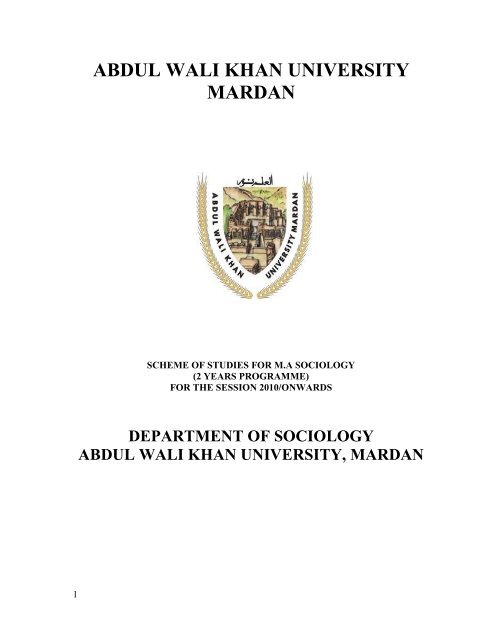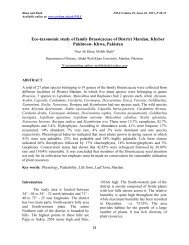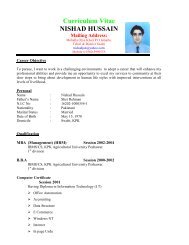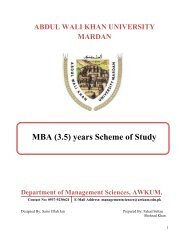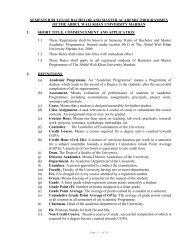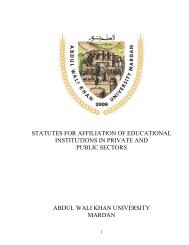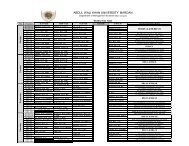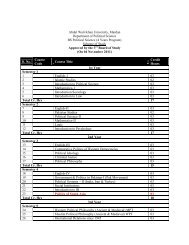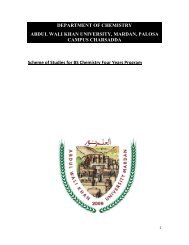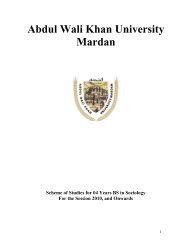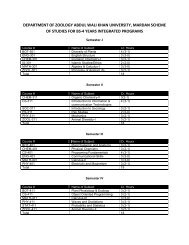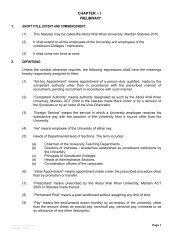Abdul Wali Khan University Mardan - AWKUM
Abdul Wali Khan University Mardan - AWKUM
Abdul Wali Khan University Mardan - AWKUM
Create successful ePaper yourself
Turn your PDF publications into a flip-book with our unique Google optimized e-Paper software.
1<br />
ABDUL WALI KHAN UNIVERSITY<br />
MARDAN<br />
SCHEME OF STUDIES FOR M.A SOCIOLOGY<br />
(2 YEARS PROGRAMME)<br />
FOR THE SESSION 2010/ONWARDS<br />
DEPARTMENT OF SOCIOLOGY<br />
ABDUL WALI KHAN UNIVERSITY, MARDAN
INTRODUCTION TO M.A IN SOCIOLOGY PROGRAMME:-<br />
The M.A in Sociology is taught at the newly established department of sociology at<br />
Palosa Campus of <strong>Abdul</strong> <strong>Wali</strong> <strong>Khan</strong> <strong>University</strong>, <strong>Mardan</strong>. The department of sociology through<br />
its Master degree program provides a very strong academic foundation to students who intends<br />
to pursue higher degree of PhD, as well as, to students who intend to further and enhances their<br />
career‟s prospects in the non-profit, or NGOs, community development and social welfare<br />
sectors.<br />
The M.A in sociology will not only educate students in basic sociological concepts,<br />
sociological debates and trends in sociology as well as major social issues and social problems<br />
but will also train them in sociological analysis, sociological imagination, social explanation.<br />
In addition, by getting M.A degree in sociology the student would get training in social<br />
research methodology and will be equipped in using different research methods and tools.<br />
In general the student will have knowledge about the nature of different sociological<br />
explanations, their possibilities and methodological implications. Rationality and its limits,<br />
with regard to both individual agents and institutions. The interrelationships between<br />
description and explanation; theory and empirical data; macro- and micro-levels of analysis; as<br />
they emerge from areas of major sociological enquiry.<br />
PROGRAMME STRUCTURE:<br />
The Programme is offered only full-time and on regular basis with a total of 19<br />
modules, including 6 Core or Major modules/subjects and compulsory field work and<br />
dissertation. The degree is of two years duration minimum and a total of 4 semesters. Only<br />
those student will be eligible to do dissertation who have achieved at least 3 CGPA at the end<br />
second semester. Those students who do dissertation will get a degree with the title of “M.A in<br />
Sociology (with dissertation)” and the student who did not complete dissertation will get a<br />
degree with the title of “M.A in Sociology (Course Work Only/Taught). Below is the list of<br />
both major and other subjects and modules:<br />
Core/Majors Modules/Subjects: Other Subjects/Modules:<br />
Principles of Sociology Social Psychology<br />
Sociological Theory Environmental Sociology<br />
Social Research Methods Social Institutions<br />
Social Change and Development Rural Sociology<br />
Community Development Disaster Management<br />
Gender and Development Criminology<br />
Social Demography Sociology of Pakhtun Society and Culture<br />
Social Statistics and SPSS<br />
Sociology of Information and Communication<br />
Technologies<br />
Project Management<br />
Field work and,<br />
Dissertation.<br />
2
AIMS/OBJECTIVES/LEARNING OUTCOMES:<br />
In nutshell, at the end of this degree, the sociology graduates should have knowledge<br />
of:<br />
1. The key concepts, debates, and trends in sociology.<br />
2. The major sociological paradigms and theories.<br />
3. The variety of methods used in sociological research.<br />
3<br />
Sociology graduates will be able to:<br />
A. Show evidence of the development of a sociological imagination by applying<br />
sociological knowledge in their own projects-whether intellectual, personal, and/or<br />
political.<br />
B. Exhibit confidence in expressing ideas orally and in writing.
4<br />
SCHEME OF STUDIES FOR MA SOCIOLOGY PROGRAME:<br />
Course<br />
code<br />
Title of Courses Marks Credit hours<br />
SOC 401 Principles of Sociology 100 04<br />
SOC 402 Community Development 100 04<br />
SOC 410 Social Demography 100 03<br />
SOC 419 Social Psychology 100 03<br />
SOC 405 Social Institutions 100 03<br />
Semester -II<br />
Total 17<br />
Course<br />
code<br />
Title of Courses Marks Credit hours<br />
SOC 403 Sociological Theories 100 04<br />
SOC 406 Sociology of Pakhtun society and<br />
culture<br />
100 03<br />
SOC 408 Social Change and Development 100 04<br />
SOC 409 Environmental Sociology 100 03<br />
SOC 416 Social Problems of Pakistani Society 100 03<br />
Semester –III<br />
Total 17<br />
Course<br />
Code<br />
Title of Courses Marks Credit Hours<br />
SOC 412 Rural Sociology 100 03<br />
SOC 411 Disaster Management 100 03<br />
SOC 414 Criminology 100 03<br />
SOC 415 Social Research Methods 100 04<br />
SOC 422 Field Work 100 04<br />
Semester -IV<br />
Total 17<br />
Course<br />
Code<br />
Title of Courses Marks Credit Hours<br />
SOC 433 Gender and Development 100 04<br />
SOC 429 Project Management 100 03<br />
SOC 418 Sociology of Information & 100 03<br />
SOC 421<br />
Communication Technologies (ICTs).<br />
Social Statistics and SPSS 100 03<br />
SOC 440 Dissertation 200 06<br />
Total 19<br />
Grand Total Credit Hours 70
COURSE TITLE: PRINCIPLES OF SOCIOLOGY<br />
COURSE CODE: SOC 401<br />
CREDIT HOURS: 4<br />
Course Aims and Objective:<br />
The course is designed to introduce the students with sociological concepts and the discipline.<br />
The focus of the course shall be on major concepts like social systems and structures, socioeconomic<br />
changes and social processes. The course will provide due foundation for further<br />
studies in the field of sociology.<br />
Course Outline<br />
1. Introduction<br />
� Definition, Scope, and Subject Matter<br />
� Sociological imagination<br />
� Nature of Sociology<br />
� Historical background of Sociology<br />
� Importance of studying sociology<br />
2. Perspectives in Sociology<br />
� Structural Functionalist perspective<br />
� Conflict perspective<br />
� Symbolic Interactionist perspective<br />
� Global perspective<br />
3. Culture<br />
� Definition, aspects and characteristics of Culture<br />
� Material and non material culture/culture and civilization<br />
� Ideal and real culture<br />
� Elements of culture<br />
� Norms and social sanctions<br />
� Cultural Relativism<br />
� Sub Cultures<br />
� Ethnocentrism and Xenocentrism<br />
� Cultural change and related concepts<br />
4. Socialization & Personality<br />
� Socialization, Agencies of Socialization<br />
� Self<br />
� Personality, Factors in Personality Formation<br />
� Theories of socialization and personality development<br />
� Role & Status<br />
5. Social Processes<br />
� Social interaction and forms of social interaction<br />
5
� Cooperation<br />
� Competition<br />
� Conflict<br />
� Assimilation and acculturation<br />
� Accommodation<br />
6. Social Groups<br />
� Definition<br />
� Types of social groups<br />
� In and out groups<br />
� Primary and Secondary group<br />
� Reference groups<br />
� Bureaucracy<br />
� Pressure groups<br />
7. Social Inequality and Social Stratification<br />
� Social Class<br />
� Caste<br />
� Gender<br />
� Race<br />
� Social Mobility and types of social mobility<br />
� Income inequality<br />
Recommended Books:<br />
1. Ballantine, Jeanne H. and Roberts, Keith A. (Condensed Version) 2010. Our Social World.<br />
California: Pine Forge Press/Sage Publication.<br />
2. Brown, Ken 2004. Sociology. United Kingdom: Polity Press<br />
3. Brym, Robert J. and Lie, John. Sociology: Your compass for a new world (Brief Edition) 2007<br />
Belmont: Thomson Wadsworth.<br />
4. Colander, David C. and Hunt, Elgin F. (Thirteenth Edition) (2010) Social Sciences: An<br />
introduction to the study of Society. India: Pearson Education/Dorling Dindersley.<br />
5. Gidden, Anthony 2002. Introduction to Sociology. UK: Polity Press.<br />
6. Rao, C. N. Shankar (2008) „Sociology: Principles of Sociology with an Introduction to Social<br />
Throughts‟ New Delhi: S. Chand & Company.<br />
7. James M. Henslin. (2004). Sociology: A Down to Earth Approach. Toronto: Allen and Bacon.<br />
8. Macionis, John J. (2006). 10 th Edition Sociology New Jersey: Prentice-Hall<br />
9. Montuschi, Eleonora. (2006). The Objects of Social Sciences New York: Continuum.<br />
10. Hortun, Paul B. and Hunt, Chester L. 1984. Sociology. New York: McGraw-Hill<br />
6
COURSE TITLE: COMMUNITY DEVELOPMENT<br />
COURSE CODE: SOC 402<br />
CREDIT HOURS: 4<br />
Aims and Objectives:<br />
The course aims at acquainting the students with the basic concepts of community<br />
development, approaches, strategies and theories. The emphasis will be placed on<br />
community mobilization and organization. The course will also cover the participatory<br />
development and different models of community development.<br />
Contents:<br />
1. Introduction:<br />
� Definition and explanation of terms “Community” and “Development”<br />
� Community development- definition and explanation<br />
� Aims and objectives of community development<br />
� Basic Principles, Approaches and Techniques of community development<br />
� Social organization, its process and barriers<br />
� Community Capacity Building<br />
� Impacts of Capacity Building on Communities.<br />
2. Community Participation:<br />
� Meaning of Participation<br />
� Role of Participation in development process<br />
� Types of participation<br />
� Various participatory approaches<br />
� RARA Participatory Appreciative Planning Approach<br />
� RRA- Rapid Rural Appraisal<br />
� PAR-Participatory Action Research<br />
� PRA- Participatory Research Action<br />
� PRA-Participatory Rural Appraisal<br />
� Tools and Techniques:<br />
� Review of secondary data<br />
� Semi Structured Interviews (a. Probing, B. Interview Protocol)<br />
� Diagrams<br />
� Direct Observation<br />
� Ranking and qualification method-wealth ranking<br />
� Preference/problem ranking e.g., Pair Ranking<br />
� Photographs and games<br />
� Dimension of PRA<br />
� PRA as a participatory alternative in development and research<br />
� PRA as a set of principles<br />
� PRA as a set of data gathering and awareness raising tool<br />
� PRA as a method of participatory project management<br />
� PRA for addressing specific issues<br />
7
� PRA as work in progress<br />
� PRA as family of approaches<br />
3. Community Development in Practice<br />
� Community Development Programs in Pakistan<br />
� History of Community Development before Partition of the Sub-continent- Camilla<br />
Project<br />
� Community Development with Reference to Village-AID Program, Rural Works<br />
program, People‟s Work Program, Social Action program, Khushal Pakistan Program,<br />
Rural Support Program.<br />
� Community Development Programs in Underdeveloped Countries of Asia and Africa:<br />
India, Pakistan, Bangladesh, Kenya, Thailand, Egypt and Philippines.<br />
4. Social Mobilization<br />
� Meaning<br />
� Getting prepared<br />
� Getting started<br />
� Organizing the community into action<br />
� Sustaining the Intervention<br />
5. Attitude, Knowledge and Skills for effective Community Development<br />
� Attitude<br />
� Knowledge<br />
� Skills<br />
� Communication, Facilitation and Team-Building Skills<br />
� Research, Planning and Evaluation Skills<br />
� Problem Solving and Conflict Resolution Skills<br />
� Management Skills<br />
� Organizational Design and Development Skills<br />
� Building on Skills and Responding<br />
6. Development through NGOs.<br />
� Salient features of NGOS<br />
� NGOS‟ historical background in Pakistan<br />
� Role and importance of NGOS<br />
� Charges on NGOS<br />
� Policy alternatives for check and balance<br />
Recommended Books:<br />
1. Burkey, S. 1996 People first- a guide to self reliant participatory rural<br />
development. Zed Books.<br />
2. Cooke, B. and Kothari, U (Eds) 2002 Participation: The New Tyranny? Zed<br />
Books: London<br />
8
3. Cooke, B. 2003 „A New continuity with colonial administration: Participation in<br />
development management‟, Third World Quarterly 24:1, 47-61.<br />
4. Frank, Flo and Smith, Anne 1999 „The Community Development Handbook‟<br />
[Available at http://www.hrdc-drhc.gc.ca/community]<br />
5. IFAD 2001 „Enhancing Ownership and Sustainability‟.<br />
6. R Chambers 1997 „Whose reality counts‟. ITDG.<br />
7. Twelvetrees, Alan. 2008. Community Work. Palgrave: New York.<br />
8. Zari, Rafiq Dr. 2009 „Community Development: Concepts and Practice‟<br />
Peshawar: <strong>University</strong> of Peshawar.<br />
Classical and renowned Books:<br />
1. Edwards, M. and Hulme, D. (eds.), (1992), Making a Difference: NGOs and<br />
development in a Changing world. London: Earthscan Publication.<br />
2. Chambers, R. 2007 „Ideas for development‟ IDS working paper 238:<br />
9
COURSE TITLE: INTRODUCTION TO SOCIAL DEMOGRAPHY<br />
COURSE CODE: SOC 410<br />
CREDIT HOURSE: 3<br />
Aims and Objectives:<br />
The course is designed to help the students to understand that sociology has a significant<br />
responsibility to contribute to population planning activities. It is further to help the students to<br />
recognize that the problem of population planning require entire professional activity or<br />
approach.<br />
To impart knowledge of demography and its methods to student to equip them to contribute<br />
fully to the goal of population control and development of nation.<br />
Course Contents:<br />
1. Introduction to Social Demography<br />
� Introduction<br />
� History of social demography<br />
� Importance of studying social demography<br />
2. Sources of Demographic Data:<br />
� Populaiton census<br />
� History of population census<br />
� Meaning and Definition of Census<br />
� Procedure of Census<br />
� De facto population and de jure population<br />
� Census Errors- Coverage error, Content error<br />
� History of viatal events<br />
� Importance of statistics<br />
� Combining the census and vital statistics<br />
� Sample Surveys<br />
� Dual Report System<br />
2. Basic Demographic Methods<br />
� Measures of population structure, pyramid, age and sex ratio dependency ratio,<br />
distributive measures<br />
� Measure of population change: natural increase rate, standardization of rates and net<br />
reproduction rate and migration rate<br />
3. Demographic Processes, Concepts and Terms.<br />
� Demographic concepts: Birth Rate, Death Rate and Fertility Rate.<br />
� The composition of population: Age, Sex, Urban Rural Economic conditions, Education,<br />
Race Ethnicity, Religion, and Marriage.<br />
� Mortality<br />
� Defining health and mortality transition<br />
� Health and mortality over time (Roman to the Twentieth Century)<br />
10
� World War 2 nd as a modern turning point<br />
� Postponing death by preventing and curing diseases<br />
� Diseases and death over the life cycle<br />
� Age differentials in mortality<br />
� Sex and gender differentials<br />
� Causes of poor health and death<br />
� Measuring mortality<br />
� Fertility<br />
� Some concepts of fertility<br />
� Fertility, Fecundity, Natural fertility, Controlled fertility, Theoretical maximum fertility, Still<br />
birth, Reproductive wastage, Abortions, Sterilization, Adolescent sterility, Post-partum<br />
sterility, Primary and secondary sterility, Complete abstinence, Birth order, Parity.<br />
� Causes of high birth rate in our society<br />
� Causes of decreasing fertility<br />
� How can the fertility be decreased or controlled?<br />
� Measures of fertility<br />
� Migration and Urbanization<br />
� Definition, types, causes and consequences of migration<br />
� Definition, factors, measures and causes of urbanization.<br />
4. Principles of Population Dynamics.<br />
� Factors effecting population trends and the demographic transition.<br />
� Political factors involved in population Dynamics including public policy Programme.<br />
� Immigration and migration as influences in population dynamics.<br />
� Predictions and projections for future population.<br />
5. Theories of Population:<br />
� Early thinking on population<br />
� Prescriptions of great religions<br />
� Malthusian Theory<br />
� Neo-Malthusian Theory<br />
� Demographic Transition Theory by Frank W. Notestein<br />
RECOMMENDED BOOKS:<br />
1.Alam, Anwar. 2006. „Demography: Population Explosion and Control‟. Peshawar: Saif<br />
Printing Press.<br />
2. Domency, Paul and McNicoll, Geoffrey (Edited) 2003. „Dncyclopedia of Population‟.<br />
USA: Gale.<br />
3.Pandey, G. S. 2010. Introduction to Social Demography. New Delhi: Swastick.<br />
4.Seth, Padma. 2009. Infant Mortality and Maternal Mortality, New York, Gyan<br />
Publishing House.<br />
5.Sinha, B.R.K. 2009. Population, Environment and Development: A Global Challenge for<br />
the 21 st Century. New Delhi: New Century Publications.<br />
11
6. Weeks, John R. 2008 „Population: An Introduction to Concepts and Issues‟. Belmont:<br />
Wadsworth, Cengage Learning.<br />
12
COURSE TITLE: INTRODUCTION TO SOCIAL PSYCHOLOGY<br />
COURSE CODE: SOC 419<br />
CREDIT HOURSE: 3<br />
AIMS AND OBJECTIVES:<br />
The course aims at familiarizing the students with the historical emergence, concepts,<br />
methods and theories of social psychology. It also focuses on highlighting the impact of<br />
culture on the personality development. The course would enable the students to<br />
conceptualize the dynamics and structure of social self.<br />
CONTENTS:<br />
1. Introduction<br />
� Introduction and Meaning of social psychology<br />
� Scope/Subject Matter of social psychology<br />
� Historical background of social psychology<br />
� Relationship between sociology and social psychology<br />
� Methods of social psychology.<br />
2. Social relationship<br />
� Prejudice<br />
� Aggression<br />
� Attraction<br />
� Stereotyping and Discrimination.<br />
� Conflict<br />
� Emotions<br />
3. Psychological explanation of Human Behaviour<br />
� Introduction to human behaviour<br />
� Psycho-Analytic theory<br />
� Social Learning theory<br />
� Cognitive or information process theory<br />
� Evolutionary theory<br />
� Behaviourism<br />
4. Cognition, Perception and Attitude<br />
� Attitude<br />
� Components of attitude<br />
� Characteristics of attitude<br />
� Formation of attitude<br />
� Attitude Change.<br />
� Introduction to cognition and perception<br />
� Person perception and object perception<br />
� Non verbal mediators person perception<br />
13
� Accuracy of person perception<br />
5. Personality and Environment<br />
� Individual and environment<br />
� Individual motivation<br />
� Effect of environment on personality<br />
� Socializations<br />
� Personality<br />
� Measurement<br />
Recommended Book:<br />
1. Baren, Robert A, Byrne, Donn and Branscobe, Nyla R. 2006 (11 th Ed). Social<br />
Psychology, New Delhi: Pearson.<br />
2. Baren, Robert. 2008. Social Psychology, New Delhi: Pearson.<br />
3. Parkash, Dr. Dev. 2010. Social Psychology, New Delhi: Lotus Press.<br />
4. Winnicott, D. W. 2006. The Family and Individual Development. New York, Rutledge.<br />
5. Zastrow, Charles and Kirst-Ashman, Karen K. Understanding Human Behaviour and<br />
the Social Environment. Belmont: Thomson Higher Education.<br />
6.<br />
14
COURSE TITLE: SOCIAL INSTITUTIONS<br />
COURSE CODE: SOC 405<br />
CREDIT HOURS: 3<br />
Aims and Objectives:<br />
The purpose of this course is to acquaint students with the structure and function of society as<br />
well as social institutions, social structure and its influence on human behavior and how it<br />
shape social reality. How social institutions maintains it selves and how it change.<br />
Contents:<br />
1. Definition and description of “Social Institutions”.<br />
� Features/Characteristics of social institutions<br />
� Functionalist and conflict views on social institutions<br />
� Classification of social institutions<br />
� Functions<br />
� The importance of social institutions<br />
� The development of social institutions<br />
� The interconnections and inter-relationship between institutions.<br />
2. Types of Social Institutions.<br />
� Primary social institutions<br />
� Secondary social institutions<br />
3. Family and Marriage<br />
� Introduction<br />
� Definition of family and marriage<br />
� Difference between family and marriage<br />
� General structure and functions of family and marriage<br />
� Marriage patterns<br />
� Residential patterns<br />
� Patterns of descent<br />
� Patterns of authority<br />
� Theoretical analysis of family<br />
4. Economy and Work<br />
� Introduction and definition of family institution<br />
� Historical overview<br />
� Three major revolution which reshapes and give birth to modern economy- Agricultural<br />
Revolution Industrial Revolution and the Information Revolution.<br />
� General structure and functions of economy<br />
� Sectors of the economy-Primary, Secondary, Tertiary sectors<br />
� Various Economic Systems-Capitalism, Socialism, Welfare and State-capitalism,<br />
� Work in the Post-industrial economy<br />
� Professions<br />
� New information technology and work<br />
15
� The debate of Market vs. State<br />
� Multinational companies and Third World Countries<br />
5. Religion<br />
� Introduction and definition<br />
� Structure and Functions<br />
� Theoretical analysis and functions of religion<br />
� Religion and social change-Protestant ethics and the rise of capitalism<br />
6. Politics/Government.<br />
� Introduction and Definition<br />
� General Structure and functions<br />
� The Concepts of Power and Authority-Traditional, Legal-Rational and Charismatic<br />
� Politics in Global Perspective<br />
� -Monarchy<br />
� Democracy<br />
� Authoritarianism<br />
� Totalitarianism<br />
� A Global political system?<br />
� Theoretical analysis of Power in Society-Pluralist Model, The Power-Elite Model, The<br />
Marxist Model<br />
� Power beyond the rules<br />
� Revolution<br />
� Terrorism<br />
� War and Peace<br />
7. Education.<br />
� Introduction and Definition<br />
� Structure and functions<br />
� Schooling and economic development<br />
� Schooling and social inequality<br />
� Problems in the school, and unrest in universities<br />
� Theoretical analysis of education or schooling<br />
8. Introduction to Civil society organizations<br />
� Community Based Organizations<br />
� Community Citizen Board<br />
� Non Government Organizations<br />
� International Non Governmental Organizations<br />
� UN Bodies<br />
� Chamber of Commerce and Industries<br />
BOOKS RECOMMENDED:<br />
16
� Ballantine, Jeanne H. and Roberts, Keith A. (Condensed Version) 2010. Our Social World.<br />
California: Pine Forge Press/Sage Publication.<br />
� Brown, Ken 2004. Sociology. United Kingdom: Polity Press<br />
� Brym, Robert J. and Lie, John. Sociology: Your compass for a new world (Brief Edition)<br />
2007 Belmont: Thomson Wadsworth.<br />
� Colander, David C. and Hunt, Elgin F. (Thirteenth Edition) 2010 Social Sciences: An<br />
introduction to the study of Society. India: Pearson Education/Dorling Dindersley.<br />
� Gidden, Anthony 2002. Introduction to Sociology. UK: Polity Press.<br />
� Hortun, Paul B. and Hunt, Chester L. 1984. Sociology. New York: McGraw-Hill<br />
� James M. Henslin. 2004. Sociology: A Down to Earth Approach. Toronto: Allen and<br />
Bacon.<br />
� Macionis, John J. 2006. 10 th Edition Sociology New Jersey: Prentice-Hall<br />
� Horton Paul, B Introduction to Sociology (4 th Edition)2002, Sage: Delhi<br />
17
COURSE: SOCIOLOGICAL THEORIES<br />
COURSE CODE: SOC 403<br />
CREDIT HOURS: 4<br />
Aims and Objectives:<br />
The course provides a review of classical sociological theorists to contemporary sociological<br />
thinking. It focuses on the content and utility of classical theories in terms of understanding<br />
social world. While the course provides a general history of sociological theory, the focus<br />
remains on examining how classical theories have provided the basis for a better understanding<br />
of the character and dynamics of societies around the world. The contents of the course also<br />
help understand the nature of contemporary sociological theories.<br />
Course Contents:<br />
1. Introduction<br />
� Theory and Knowledge<br />
� Process of Theorizing<br />
� What is a sociological Theory<br />
� Types of Sociological Theories<br />
� Inductive and Deductive<br />
� Fact, Propositions, and Laws<br />
� Development of sociological theory<br />
� Social Forces<br />
� Intellectual Forces<br />
� French Revolution<br />
� Enlightenment<br />
2. Structural-Functionalist Perspective/Positivist Sociology:<br />
� Introduction<br />
� Characteristics and main assumptions<br />
� Auguste Comte<br />
� Emile Durkheim<br />
� Talcott Parsons<br />
� Robert K. Merton<br />
3. Critical-Conflict Perspective:<br />
� Introduction<br />
� Characteristic, Outlook and main assumptions<br />
� Hazart Allama Ibne Khaldun<br />
� Karl Marx<br />
� Wright Mills<br />
4. Symbolic Interactions Perspective:<br />
� Max Weber<br />
18
� George Herbert Mead<br />
� Charles. H. Cooley<br />
� Erving Goffman<br />
Recommended Books:<br />
1. Appelrouth Scott. 2007. Sociological Theory in the Contemporary Era: Text and<br />
Readings. London: Pine Forge Press.<br />
2. Bronner, Stephen Erick (latest ed.) Critical Theory and Society-A Reader, London;<br />
Rutledge and Kegan paul.<br />
3. Calhon, Craig. Ed. 2007. Contemporary Sociological Theory. 2 nd ed. Malden, USA:<br />
Blackwell Publishing.<br />
4. Emile Durkheim, 2001. The Elementary Forms of Religious Life. New York: Oxford<br />
<strong>University</strong> Press.<br />
5. Farganis, James 2000. “Readings in Social Theory: The Classic Tradition to Post-<br />
Modernism (3 rd Ed.)”. Boston: McGraw Hill.<br />
6. Gianfranco Poggi, 2000. Durkheim. New York: Oxford <strong>University</strong> Press<br />
7. John, J. Macionis. 2004. Sociology, 10 th edition. Hardcover<br />
8. Max Weber, 2001. The Protestant Ethic and the Spirit of Capitalism. Los Angeles, CA:<br />
Roxbury Publishing Co.<br />
9. Ritzer, George 2002. Sociological Theory (10 th edition). New York: McGraw Hill.<br />
COURSE TITLE: SOCIOLOGY OF PAKHTUN SOCIETY AND CULTURE<br />
COURSE CODE: SOC 406<br />
CREDIT HOURS: 3<br />
19
Aims and Objectives:<br />
Sociology is a study of relationship between human beings with others in a society including<br />
the relationship with the culture. To open the ability of holistic thinking, the students of<br />
sociology have to learn social value system of others‟ society as well as their own.<br />
The social value system of Pakhtun is chosen because Pakhtun people have proven to the world<br />
that they could be a developed society without neglecting the value of tradition. However, in<br />
the recent past, due to some global events, the perception of people around the world has<br />
changed and is getting more and more biased towards Pakhtun. The true Pakhtun culture and<br />
social system and their values systems are hidden from the world community as well as from<br />
their own fellow nationals. Therefore this course aims to introduce and depict the accurate and<br />
real culture and society to the wider audience and students of sociology. Moreover, the course<br />
will help students of sociology to do research on the different dimension of traditional value<br />
systems of Pakhtun and the socio-cultural changes happening in the Pakhtun region. Also it<br />
will help to sort out problems faced by Pakhtun in all sphere of life and will clarify the<br />
misconceptions about them.<br />
1. Introduction<br />
� History and origin of Pakhtun<br />
� Tribes, races and ethnicities among Pakhtun<br />
� Different school of thoughts on the origin of Pakhtun<br />
� Description of the Pakhtun belt and region and the impact of geography on Pakhtun culture<br />
and identity.<br />
2. Pakhtun Social Institutions<br />
� Hujra, its structure and functions<br />
� Jirga, structure, functions and its significance<br />
� Joomat (mosque) its importance and functional necessity<br />
� Madrassa, functions and its educational value for Pakhtun<br />
3. Pakhtun Culture-Pakhtunwali<br />
� Introduction to Pakhtunwali<br />
� Melmastya(Hospitality)<br />
� Badal (Revenge)<br />
� Nanawaty<br />
� Gherat (Honour)<br />
� Nang/Sharam/Patt<br />
� Purdah<br />
� Khegarah<br />
� Malamatya<br />
� Teega<br />
� Rogha<br />
� Thora and Topak<br />
� Satt<br />
20
5. Customs and Dresses<br />
� Swara, Tore, Honour Killing<br />
� Lopata, Sadar, Patkey, Wasket etc<br />
5. Pakhtun Art, Music and Literature<br />
� Musical Instruments, Sittar, Rabab, Mangai, Shpelai<br />
� Folk Literature,Tappa, Misra, Charbaita, Badala, Rubaai, Nimakai<br />
� Poets, Rahman Baba, Khushaal Baba, Hameed Baba, Hamza Baba, Ghani <strong>Khan</strong>(Lewaney<br />
Falsofy), Ajmal Khattak<br />
6. Pakhtun Social Stratification<br />
� <strong>Khan</strong>/Naik<br />
� Mullah<br />
� Kasab Ghar, Nai, Tarkan, Jola, Kolal, Henger (Lohar), Nandaf, Mazdoor,Dehqaan<br />
8.Pakhtun Social Movements<br />
� Khudai Khidmatgaar Tehreek<br />
� Khushaal against Mughal<br />
� Pakhtun Freedom movements Against British(Turangzai Haji)<br />
� Tehreek Reshmi Roomal<br />
Recommended Books:<br />
1. Ahmad, Aijaz. 2005. Frontier Gandhi: Reflections on Muslim Nationalism in India. Social<br />
Scientist 33 (Jan-Feb). 22-39.<br />
2. Banerjee, Mukulika. 2002 The Pathan unarmed: opposition and memory in the North West<br />
Frontier. Santa Fe, N. M.: School of American Research Press<br />
3. Caroe, O. K. 1965 The Pathans, London: Macmillan and Co.<br />
4. Glatzer, Bernt 2002 The Pashtun Tribal System. Chapter No. 10. in G. Pfeffer and D.<br />
K. Behera (eds.): Concepts of Tribal Society (Contemporary Society: Tribal Studies, Vol 5),<br />
New Delhi: Concept Publishers. [Accessible on: www.afghanic<br />
.de/images/whatiswhat/tribal_system.pdf.]<br />
5. Picco, Giandomenico and Palmisano, Antonio Luigi. 2007 Afghanistan: How much<br />
of the past in the new future. Istituto di Sociolgia Internazionale de Gorizia (I.S.I.G) Stampa:<br />
Grafica Goriziana.<br />
6. Spain, J. W. 1963 People of Khyber, London:<br />
7. Spain, J. W. 1973 The Pathan Borderland. (2 nd Ed.) London:<br />
COURSE TITLE: SOCIAL CHANGE AND DEVELOPMENT<br />
COURSE CODE: SOC 408<br />
21
CREDIT HOURS: 4<br />
Objective:<br />
Concepts and terms related to the issues of development shall be learnt. The students will learn<br />
about relevant theories about change and progress. Models of development related to local,<br />
regional, and global levels will be examined. Comparisons will be drawn among political,<br />
social, and economic factors of development in a variety of perspectives.<br />
Course Outline<br />
1. Introduction<br />
� Change, development, and progress<br />
� The meaning „development‟<br />
� Development and underdevelopment<br />
� Critiques of development: Eurocentric, populist stances, anti-development and post-<br />
modernity<br />
3. Theories of development<br />
� The Modernization School<br />
� Marxist and Socialist Models<br />
� Development and Underdevelopment-Dependency<br />
� Structural Adjustment Policies<br />
4. Social Change<br />
� Introduction<br />
� Various dimensions of social change<br />
� Magnitude, rate and direction of social change<br />
� Identification of social change.<br />
� Factors affecting social change<br />
5. Social Change and Development in Global Perspective<br />
� The Politics of Development: Economy, Policy, Culture<br />
� Corporations, Classes and Consumerism<br />
� Gender and Development<br />
� Transitional Practices in the Third World<br />
6. Globalization, development and underdevelopment<br />
� What does globalization mean?<br />
� Globalization and Development: for and against/solution or problem?<br />
� Global transformations: a shrinking world or a more unequal world?<br />
� Globalization and the information society: the digital divide and an unequal world<br />
� Economic aspects of globalization: industrialisation, TNCs, world cities and global shifts<br />
22
� Economic change and global divergence<br />
� Global convergence? Perspectives on cultural globalization<br />
� Political aspects of globalization: the anti-capitalist movements<br />
� Globalization and unequal development<br />
6. The Role of Aid in Development<br />
� The Role of Non-government Organizations in Development<br />
� Development in Pakistan: A Case Study<br />
Recommended Books<br />
1. Boas, Morten. 2004. Global Institutions and Development: Framing the World? London:<br />
Routledge.<br />
2. Chambers, Robert. 2005. Ideas for Development. London: Earthscan.<br />
3. Danne M waddell (2007) Organization Thoms G Cummings Christopher G Worley<br />
Development & Change Asia Pacific<br />
4. Debora heade (2005) Development NGO & Civil Society Rawat Publications Jaipur New<br />
Delhi<br />
5. Griffiths, Robert j. 2004. Developing World. Guilford: McGraw-Hill.<br />
6. Jha, A.K. 2006. Globalization & Human Resource Development in 21st Century.<br />
Lucknow: Institute for Sustainable Development.<br />
7. Katie Willis. 2005. Theories and Practices of Development. London: Routledge.<br />
8. Kothari, Uma. 2002. Development theory and Practice: Critical Perspectives. New York:<br />
Palgrave Macmillan.<br />
9. Pietese, Jan Nederveen. 2001. Development theory: Deconstruction/Reconstruction new<br />
Delhi: Vistaar Publishers.<br />
10. Sahni, Pardeep. 2003. Governance for Development: Issues and Strategies. New Delhi:<br />
Prentice Hall.<br />
11. Schech, Susanne. 2002. Development: A cultural Studies Reader. Australia: Blackwell<br />
Publishing.<br />
12. Singh, Sita Ram. 2005. Poverty Alleviation in the third world. New Delhi: APH Publishing<br />
Corporation.<br />
13. Thirlwall, A.P. 2006. Growth and Development with special reference to developing<br />
economies 6th ed.<br />
COURSE TITLE: ENVIRONMENTAL SOCIOLOGY<br />
COURSE CODE: SOC 409<br />
23
CREDIT HOURS: 3<br />
Aims and Objectives:<br />
Ecology is often described as the study of natural communities while sociology is described as<br />
the study of human communities. Environmental sociology is the study of both together, the<br />
study of the “community” in the broadest sense–people, water, land, plants, animals etc.<br />
Indeed, society and the physical environment are tightly linked in various ways.<br />
During this course, we will explore these linkages at various levels from the local to the global.<br />
Environmental sociology raises questions that contemporary “mainstream” sociology has been<br />
very concerned with, too, these last 30 years or so. Indeed, environmental sociology is highly<br />
emblematic for the challenges the “modernity” project is facing. Since the modernist<br />
dichotomy between social systems and natural systems becomes less and less tenable, new<br />
ways to account for the real and socially entangled world have to be found.<br />
The course is mainly oriented towards a theoretical discussion and is geared towards getting<br />
students acquainted with different schools of thought not only in the discussion around<br />
„environmental sociology‟ but also the discussions and cases from cognate areas of<br />
development theory, i.e. rural and urban development (including sustainable development),<br />
Sociological theory, modernity etc. The concepts, theories and paradigms of the discipline will<br />
be mainly derived from the (Rich) North‟s academic tradition. Each time, empirical examples<br />
will be provided to support the discussion, primary by analyzing examples from both the<br />
„North‟ & the „South‟<br />
Course Contents:<br />
1. Introduction<br />
� Definition and explanation of Environmental Sociology<br />
� The Birth and Growth of Environmental Sociology-Historical Background<br />
� Environmental sociology and the larger discipline<br />
� Current trends and point of debates in environmental sociology<br />
� Major paradigms in environmental sociology and discourse<br />
a. Human Exemptionlism Paradigm (HEP)<br />
b. New Ecological Paradigms (NEP)<br />
� Basic concepts and terms of environmental sociology<br />
a. Existential dualism<br />
b. Societal-environmental dialectic<br />
c. Treadmill of production<br />
d. Ecology<br />
e. Biosphere<br />
f. Ecosystem<br />
g. Environmental Justice<br />
1. Major Sociological Perspectives on Environmental Problems<br />
� Structural-Functionalism<br />
� Conflict<br />
� Symbolic interactionism<br />
24
2. Environmental Problems<br />
� Societal-Environmental interactions<br />
� Evolution of Environmental Problems<br />
� Three Main functions of environment<br />
� Societal response to environmental problems<br />
� Causes of environmental Problems<br />
� Impacts of Environmental Problems<br />
� Possible solutions of environmental problems.<br />
4. Major Environmental Issues and Problems<br />
� Resources – flow and stock resources, resource depletion<br />
� Waste and Pollution<br />
� Environmental Sinks<br />
� Waste Assimilation systems<br />
� Population growth and the environment<br />
� Biodiversity<br />
� Quality of life<br />
� Environmental problems or human problems<br />
5. Theoretical Underpinnings for the Explanation of Environmental problem<br />
� The biological nature of the human species-Nature Vs Nurture. Sociobiology<br />
� The nature of human needs and wants and satisfiers-Human needs and environmental<br />
capital, Maslow Hierarchy of needs theory, needs and satisfiers, needs in post-modern<br />
society<br />
� The conflict between individual and larger scale interests – The „Tragedy of the commons‟<br />
model and „Life-boat‟ model<br />
� The role of values in determining attitudes and behaviour – Extrinsic and Intrinsic values,<br />
values and the greens<br />
6. Sustainable Development and the Goals of Environmental Policy<br />
� The predicament off humankind: Malthusianism<br />
� The Limits to Growth thesis<br />
� What sustainable development means?<br />
� Assessing Sustainability: the three key criteria, The Capital Approach, Environmental Space<br />
approach,<br />
7. Resources and the Environment<br />
� The importance of resources in development<br />
� Resource constraints and the development process<br />
� Environmental impacts of development<br />
� The search for sustainable resource management<br />
RECOMMENDED BOOKS:<br />
25
1. Dobson, Andrew (Edited) 2003 „Fairness and Futurity: Essays on Environmental<br />
Sustainability and Social Justice‟ Oxford, Oxford.<br />
2. Hannigan, J. (2 nd Ed) 2006. „Environmental Sociology‟, London: Routledge<br />
3. Humphry, C. R. and Buttel, F. R. (1982), „Environment, Energy, and Society‟, California:<br />
Wadsworth, Inc.<br />
4. Moore, F. (1 st Ed.) 2003. „Environment and society‟, New Delhi: Dominant Publishers and<br />
Distributors<br />
5. Potter, R. B. Binns, T. A. E. Jennifer and Smith, D. 1999. „Geographies of development‟,<br />
Singapore: Addison Wesley Longman Limited<br />
6. Roberts, J. (2004), „Environmental Policy‟, London: Routledge<br />
7. Sharp, A. M. Register, C. A. & Leftwich, R. H. (9 th Ed.) 1990. „Economics of Social<br />
Issues‟, Boston: Richard D. Irwin, Inc.<br />
8. Shrivastava, A. K. 2004. „Population development, environment, and health‟, New Delhi:<br />
A P H Publishing Corporation.<br />
9. Wright, R. (ed.) 2004. „Controversies in Environmental Sociology’, New York: Cambridge<br />
<strong>University</strong> Press<br />
10. Wright, R. T. and J. N. Bernard. (8 th Ed.) 2002. „Environmental Science: Toward a<br />
sustainable future‟ New Delhi: Prentice Hall, Inc.<br />
26
COURSE TITLE: SOCIAL STATISTICS AND BASIC SPSS<br />
COURSE CODE: SOC 416<br />
CREDIT HOURS: 03<br />
Aims and Objectives:<br />
This is a basic course in statistics with particular focus on the social sciences. It is taught in a<br />
user-friendly manner with emphasis on use of SPSS, statistical analysis software commonly<br />
used in social research. The course will teach basic statistical methods in which social<br />
researchers should have facility to execute their own analyses. This includes generation of<br />
descriptive statistics, correlations, t-tests, chi-square tests, analysis of contingency tables, oneway<br />
ANOVA, and simple regression. The course will also introduce additional statistical<br />
methods about which social researchers should be knowledgeable, including multiple linear<br />
regression, logistic regression, and survey analysis. Classes will include presentation of<br />
statistical concepts underlying specific procedures, and discussion of circumstances under<br />
which a procedure is and is not appropriate. Classes will also include demonstration of<br />
statistical procedures, and interpretation of program output. Homework exercises will involve<br />
executing statistical procedures covered in class with sample data sets, and interpreting the<br />
results.<br />
Course Contents:<br />
1. What is Statistics?<br />
Definition of Statistics, what is SPSS, Population, sample Descriptive and inferential<br />
Statistics, Observations, Data, Discrete and continuous variables, Errors of measurement,<br />
Significant digits, Rounding of a Number, Collection of primary and secondary data,<br />
Sources, Editing of Data. Exercises.<br />
2. Presentation of Data<br />
Introduction, basic principles of classification and Tabulation, Constructing of a frequency<br />
distribution, Relative and Cumulative frequency distribution, Diagrams, Graphs and their<br />
Construction, Bar charts, Pie chart, Histogram, Frequency polygon and Frequency curve,<br />
Cumulative Frequency Polygon or Ogive, Historigram, Ogive for Discrete Variable. Types<br />
of frequency curves. Exercises.<br />
3. Measures of Central Tendency<br />
Introduction, Different types of Averages, Quantiles, The Mode, Empirical Relation<br />
between Mean, Median and mode, Relative Merits and Demerits of various Averages.<br />
properties of Good Average, Box and Whisker Plot, Stem and Leaf Display, definition of<br />
outliers and their detection. Exercises.<br />
4. Measures of Dispersion<br />
Introduction, Absolute and relative measures, Range, The semi-Inter-quartile Range, The<br />
Mean Deviation, The Variance and standard deviation, Change of origin and scale,<br />
Interpretation of the standard Deviation, Coefficient of variation, Properties of variance and<br />
standard Deviation, Standardized variables, Moments and Moments ratios. Exercises.<br />
27
5. Probability and Probability Distributions<br />
Discrete and continuous distributions: Binomial, Poisson and Normal Distribution.<br />
Exercises<br />
6. Sampling and Sampling Distributions<br />
Introduction, sample design and sampling frame, bias, sampling and non sampling errors,<br />
sampling with and without replacement, probability and non-probability sampling,<br />
Sampling distributions for single mean and proportion, Difference of means and<br />
proportions. Exercises.<br />
7. Hypothesis Testing<br />
Introduction, Statistical problem, null and alternative hypothesis, Type-I and Type-II errors,<br />
level of significance, Test statistics, acceptance and rejection regions, general procedure for<br />
testing of hypothesis. Exercises.<br />
8. Testing of Hypothesis- Single Population<br />
Introduction, Testing of hypothesis and confidence interval about the population mean and<br />
proportion for small and large samples, Exercises<br />
9. Testing of Hypotheses-Two or more Populations<br />
Introduction, Testing of hypothesis and confidence intervals about the difference of<br />
population means and proportions for small and large samples, Analysis of Variance and<br />
ANOVA Table. Exercises<br />
10. Testing of Hypothesis-Independence of Attributes<br />
Introduction, Contingency Tables, Testing of hypothesis about the Independence of<br />
attributes. Exercises.<br />
11. Regression and Correlation<br />
Introduction, cause and effect relationships, examples, simple linear regression, estimation<br />
of parameters and their interpretation. r and R 2 . Correlation. Coefficient of linear<br />
correlation, its estimation and interpretation. Multiple regression and interpretation of its<br />
parameters. Examples<br />
Recommended Books<br />
1. Babbie, E., F. Halley, & J., Zaino 2007. Adventures in Social Research 6th<br />
edition. Thousand Oaks: Pine Forge Press<br />
2. Earl Babbie 2010. The Practice of Social Research 12th edition. Belmont CA,<br />
Wadsworth Publishing.<br />
3. Field, Andy. (3 rd Ed) 2009. Sex, Drugs, and Rock n Roll: Discovering statistics<br />
using SPSS. Sage Publication: UK<br />
4. Haely, Joseph F. (8 th Ed) 2009. „Statistics: A Tool for Social Research‟ Belmont:<br />
WADSWORTH Cengage Learning.<br />
5. Joan Welkowitz, Barry H. Cohen, Robert B. Ewen. (6 th Edition) 2006.<br />
„Introductory Statistics for the behaviorual sciences‟ USA,: Wiley<br />
28
6. Morgan, George A. ; Leech, Nancy L.; Gloeckner, Gene W. ; and Barret, Karen<br />
C. (2 nd Ed) 2004 SPSS for Introductory Statistics: Use and Interpretations‟ New Jersey:<br />
Kawrence Erlbaum Associates, Inc.<br />
7. Muhammad, F. 2005. “Statistical Methods and Data Analysis”, Kitab Markaz,<br />
Bhawana Bazar Faisalabad.<br />
8. Stockburger, David W. 1996 „Introductory Statistics: Concepts, Models, and<br />
Applications‟ Available at www.Version 1.0.com<br />
29
COURSE TITLE: RURAL SOCIOLOGY<br />
COURSE CODE: SOC 412<br />
CREDIT HOURS: 03<br />
Aims and Objective:<br />
The course aims at providing knowledge of basic concepts of rural sociology to the<br />
students. Moreover an in-depth understanding of structure of rural society will be carried<br />
out. The course focuses on issues relating to the study of rural people and places, as well<br />
as rural related issues in both advanced and developing countries. This course is designed<br />
to explore the changing nature of rural development in the global economy.<br />
Introduction:<br />
� Introduction and meaning.<br />
� Definition and development of rural sociology<br />
� Scope and impotence of rural sociology.<br />
� The role of rural sociologist.<br />
� Subject matter of rural sociology<br />
� Rural sociology as a science.<br />
Rural social organization:<br />
� Social stratification<br />
� Rural castes and classes,<br />
� Estates, the biradiri, clan and tribes and the jirga system<br />
Social Institution in Rural Society:<br />
� Family, introduction, characteristics, functions, types of family system in rural<br />
� Pakistan.<br />
� The changing pattern of rural family system and the impact of urbanization<br />
Migration,<br />
Modernization and rapid social change.<br />
� Education, introduction, meaning, definition and its various types of education<br />
e.g. –<br />
� Informal, formal and the non-formal. The role of mosques and madras‟s in rural<br />
Education.<br />
� The problem in the way of rural education with reference to female education in<br />
Pakistan.<br />
� Political institution, its meaning, definition and functions. Forms of authority<br />
and its<br />
basis in rural areas of Pakistan.<br />
� Local government, structure, historical development of local government in<br />
Pakistan. The role of local government in people political education and in the<br />
development of rural physical and social infrastructure.<br />
� Religious institution, its meaning and functions in rural society.<br />
� Economic institution, its structure, functions, and the role of agriculture in rural<br />
economy.<br />
� The concept of reciprocity and exchange in rural areas of Pakistan.<br />
30
� Technological development and the rural economy. The problems faced by rural<br />
economy.<br />
Social Process of Rural Society<br />
� Co – operation and its forms, forms of cooperation in rural areas.<br />
� Conflict, its types and the basis of conflicts in rural areas of Pakistan.<br />
� Competition and its forms, the various sources of competition in rural areas of<br />
Pakistan.<br />
� Accommodation and the settlement of disputes. The role of Jirga, beraderi, in<br />
the settlement of disputes.<br />
� Faction, feuds and the resolution of conflict in Pakistan.<br />
Physical Development in Rural Society:<br />
� Physical infrastructure development<br />
� Basic needs and Approaches in rural development.<br />
� Agricultural development.<br />
� Means of communication, roads, and market development.<br />
� Health and recreation facilities.<br />
Rural Society in Transition:<br />
� Meaning of change and transition.<br />
� Rural poverty and rural development.<br />
� Field of agriculture<br />
� Field of education<br />
� Economics problems<br />
� Factionalism<br />
Development, Change and Rural Women and Problems in Pakistan<br />
� Changing status of women<br />
� Rural women as an agent for development<br />
� Economics status of rural women<br />
� Participation of rural women in the protection of environment<br />
� Role of women as manager of domestic energy<br />
� Income generation scheme s for rural women<br />
COURSE RECOMMENDED BOOKS:<br />
1. CHITAMBER, J.B. (2003). An introduction to rural sociology. New Delhi:<br />
Balley Eastern Limited.<br />
2. Dalal, B. (2003). Rural Planning in Developing Countries, New Delh: Earthscan.<br />
3. <strong>Khan</strong>, Nowshad. (2000). Rural Poverty Alleviation. Islamabad:National Book<br />
Foundation.<br />
4. Kolb, John. H.L. (1989). A Study of Rural Sociology (4th Edition). London:<br />
Houghton Mifflin.<br />
5. Sahibzada, Mohibul Haq. (1997). Poverty Alleviation. Islamabad: Institute of<br />
Policy Studies.<br />
6. Social Policy and Development Centre.(2000). Social Development in<br />
Pakistan.New York: Oxford <strong>University</strong> Press.<br />
31
COURSE TITLE: DISASTER MANAGEMENT<br />
COURSE CODE: SOC 411<br />
CREDIT HOURS: 3<br />
Aims and Objectives:<br />
More and more the need to consider „natural‟ disasters and their impacts as part of the wider<br />
development discourse is recognized. While aiming to introduce students to the contemporary<br />
disaster debates, the course will also use concrete examples and evidence from recent events to<br />
highlight „good practice‟ in relief and reconstruction efforts from a gendered vulnerability<br />
perspective. The oft-ignored issues of emotional trauma, increased violence and spatial and<br />
social dislocation that disasters may provoke will also be considered in some depth, alongside<br />
discussion of the possibilities for change that large-scale disaster offer.<br />
More specifically, the students of this course will get an understanding of the underlying<br />
causes of „natural‟ disasters and their links with present developmental processes. Additionally,<br />
basic knowledge of relief and reconstruction initiatives and gender frameworks for their<br />
implementation. Plus understanding of the possible wider implications of disasters both<br />
„negative‟, the trauma and violence that may follow, and the possibilities for positive social<br />
transformation.<br />
32
Course Contents:<br />
� What is disaster and Hazard and the difference between disaster and hazard,<br />
� Types of disasters-Natural disasters and Man-made disaster including Famine, Biological<br />
hazards, Floods, Storms, Earthquakes, Volcanic Eruptions, Accidents, Political and complex<br />
emergencies<br />
� Points of debate and myths about disaster and development<br />
� What is relief, emergency response (Sphere Project) , and rehabilitation<br />
� What is vulnerability and risk<br />
� The role of local, national and international agencies in disaster response<br />
� The role of media in disaster response<br />
� Secondary disasters: Trauma or Psycho-social aspect and Violence<br />
� Community based disaster risk management, importance of community-based<br />
� Global Policy Framework: Hyogo framework For Action 2005-2015<br />
RECOMMENDED READINGS:<br />
1. Alley, E et al (1993) Combating the vulnerability of communities in P. Meriman and C.<br />
Browitt (eds) Natural Disasters: Protecting vulnerable communities Thomas Telford, London.<br />
2. Alexander, D (2000) Confronting Catastrophe: New perspectives on Natural Disasters. New<br />
York: Oxford <strong>University</strong> Press.<br />
3. Anderson, M. and Woodrow, P. (1999) Rising from the Ashes: Development Strategies in<br />
Times of Disasters, 2 nd ed. London, IT Press.<br />
4. Blaikie, Piers et al (1994) At Risk: Natural Hazards, People‟s vulnerability and Disasters<br />
Routledge, London and New York<br />
5. Enarson, E and Morrow, B (eds) (1998) The Gendered Terrain of Disaster: Through Women‟s<br />
Eyes. Westport<br />
6. Godschalk, D. et al, 1999 Natural Hazard Mitigation: Recasting Disaster Policy and Planning.<br />
Washington, D.C.; Island Press.<br />
7. Lewis, J (1999) Development in Disaster-prone Places: Studies of vulnerability. Intermediate<br />
Technology Publications, London.<br />
8. Maskrey, A (1989) Disaster Mitigation: A Community Based Approach. Oxford: Oxfam.<br />
9. Wood, A et al (eds) (2001) Evaluating International Humanitarian Action: reflections from<br />
practitioners Zed Books: London and New York<br />
10. Varley, A (ed) (1994) Disasters, Development and Environment, Chichester: Wiley<br />
33
COURSE TITLE: CRIMINOLOGY<br />
COURSE CODE: SOC 414<br />
CREDIT HOURS: 3<br />
Aims and Objectives:<br />
To help students develop understanding of the dynamics, origins and cause of Social<br />
Deviation, Delinquency and Crime, especially among adolescents and youth. To impart<br />
knowledge about the increasing incidence of crime with in the context of our socio- economic<br />
and cultural environment.<br />
1. Introduction<br />
� Introduction to criminology<br />
� Scope, Nature and subject matter of criminology<br />
� Criminology and criminal law<br />
� Definition(Legal and Non Legal), meaning and concept of Crime<br />
� Elements of crimes<br />
� Deviance and Crime.<br />
� Explanation of Crime in social and cultural context<br />
2. Crime and Criminal<br />
34
� Types of the crime and criminals<br />
� (Violent crimes, property crimes, business crimes and Organized crimes)<br />
� Causes of crimes<br />
� Remedies of the crimes<br />
3. Theoretical Explanation of Crime.<br />
� Introduction of old Theories<br />
� Biological Theory of Crime) (Lambroso, Sheldon)<br />
� Sociological theory of crime<br />
� Social - process and social- structure approach (Sutherland, Durkheim, Robert K Merton,<br />
Karl Marx)<br />
� Psychological theory (Sigmund Freud, Skinner )<br />
4. Agencies Controlling Crime<br />
� Formal and informal control of crime and criminal behavior<br />
� Role of Social institutions in prevention and detection of crime, like family, school peer<br />
group etc.<br />
� Structure and Role of formal institutions e.g.<br />
� Police, F.I.A C.I.A C.I.D etc.<br />
5 . Crime Statistics<br />
� Introduction<br />
� Sources, Difficulties and Needs<br />
� National crime statistics and its sociological interpretation<br />
� International crime statistics and its sociological interpretation<br />
� Problems of validity and reliability<br />
6. Probation and Parole<br />
� Definition of probation and parole.<br />
� Role of probation and parole officers.<br />
� Difference between probation and parole.<br />
� Social investigation in probation.<br />
7 Juvenile Delinquency<br />
� Introduction and Definition<br />
� Causes and remedies<br />
� Juvenile reformatories<br />
8 Theories of Punishment<br />
� Retributive.<br />
� Deterrence.<br />
� Social Solidarity<br />
� Reformative.<br />
� Islamic concept of crimes and its punishment<br />
35
BOOKS RECOMMENDED.<br />
1. P.P.C Law Publication Pakistan, P.L.D Publisher Nabha Road, Lohore.<br />
2. Lan Brownlex, Langmen 1998 Community Punishment, A Critical Introduction, London<br />
and New York.<br />
3. Macionis, John J. 2006. 10 th Edition Sociology New Jersey: Prentice-Hall<br />
4. Rouald L. Akers (2 nd Ed) 1999 „Criminological Theories introduction and Evaluation, (2 nd<br />
Edition) Fitzroy Dearborn Publisher, Chicago- London-..<br />
5. Sutherland Edwin II Donald R Gessay 2001. Principles of criminology New york J. B<br />
Lipoincott company.<br />
COURSE TITLE: FIELD WORK<br />
COURSE CODE: SOC 422<br />
CREDIT HOURS: 4<br />
Aims and Objectives:<br />
The Field Work is aimed at providing practical experience to gain professional knowledge and<br />
develop skills and attitudes appropriate to the practice of Sociology. It is designed to give<br />
students “real world” experience to complement and enhance their classroom studies. An<br />
academic complements the work experience. The sociology students of M.A (Third<br />
Semester/Final year) classes will carryout Block Field Work under the supervision of a faculty<br />
member in a any social set up or community level.<br />
Details/Description:<br />
The minimum requirements for the Field Work will be 3 credit hours of Sociology field work<br />
practice in the field for an academic year. The Block Field Work will be a minimum period of<br />
7 days and maximum 10 days. The student of Field Work will be assessed and graded on the<br />
following criteria by faculty member supervising the field work:-<br />
General capacity for understanding and translating in effective practice the concepts of<br />
ethnographic field work and leadership ability in sociology in terms of the following qualities:<br />
i) Degree of initiative.<br />
36
ii) Ability to interpret the aims of study.<br />
iii) Ability to develop co-operation among people.<br />
iv) Quality of relationship with individual and groups.<br />
v) Consistency and persistency in terms of goals and objectives.<br />
vi) Administrative ability.<br />
vii) General sense of responsibility about the job.<br />
B. Ability to work constructively in a team.<br />
C. Response to individual potentiality for further growth<br />
D. Use of professional literature and its application fieldwork.<br />
Before assigning the agency for their Field Work Practice, the students will be provided with<br />
proper orientation. They will be informed that an observational plan will be followed after<br />
classroom orientation for fieldwork. The students will have to visit different agencies during<br />
the orientation phase and will have to write comprehensive reports on each visit by using<br />
guidelines given to them on the observation visit proforma.<br />
3. For the assessment of student‟s performance following reports/items have to be taken in<br />
considerations as process: -<br />
1. Schedule - 70 percent of the required time<br />
2. Orientation - Visit to the agencies<br />
3. Reporting - Shall submit at the end of field work trip<br />
Daily presentation in the field and final reports to the Supervisor.<br />
4. Supervision - Academic and field<br />
5. Presentation - The students have to<br />
give presentation of their field Work in presence of the class, faculty.<br />
6. Evaluation - Should be done as per criteria lay down.<br />
All the departments have to nominate a faculty member to co-ordinate Field Work activities.<br />
He/She will be responsible to co-ordinate and liaise with the other members of the faculty and<br />
finalize the students placement.<br />
- The coordinator has to establish rapport and keep in contact with the field supervisors also.<br />
- To organize field seminars, he/she will extend support and guidance to the students.<br />
- Evaluation and presentation of the student have to be coordinated from this form.<br />
- Arrangement of transport (if and when required) is his responsibilities.<br />
37
COURSE TITLE: - SOCIAL RESEARCH METHODS<br />
COURSE CODE:- SOC 415<br />
CREDIT HOURS: 4<br />
Course Objective:<br />
The course aims to learn about the basic concepts of social research, various research<br />
methodologies, both quantitative and qualitative. The students will learn about the usage of<br />
various methodologies while conducting research on different topics. The main tools and<br />
research techniques will be studied. It is assumed that the students have a background in basic<br />
social statistics and in social theories. The students will also learn about certain specific<br />
computer software like SPSS.<br />
Course Contents<br />
1. Introduction<br />
� Characteristics of scientific- social research<br />
� Theory and research<br />
� Types of social research<br />
� Qualitative and Quantitative<br />
� Quality of good researcher<br />
38
2. Steps in Research<br />
� Choosing the problem and its significance<br />
� Review of relevant literature<br />
� Justification of Topic<br />
� Theoretical framework<br />
� Formulation of Objectives<br />
� Formulation of research question<br />
� Conceptualizing and Operationalizing<br />
� Derivation of research hypothesis<br />
� The time dimension:<br />
� cross sectional studies<br />
� longitudinal studies<br />
3. Sampling<br />
� Types of Sampling<br />
� Sampling Techniques<br />
� Preparation of Sampling Frame<br />
� Sampling Size<br />
� Error and Control<br />
4. Tools of Data Collection<br />
� Questionnaire<br />
� Interview Schedule<br />
� Checklist<br />
� Observation<br />
� Focus Group Discussion / Interview(FGD/I)<br />
5. Data Collection and Processing<br />
� Sources of Data<br />
� Methods of Data Collection<br />
� Survey method<br />
� Experimental method<br />
� Case study method<br />
� Content Analysis<br />
� Data Management<br />
� Data Analysis Techniques<br />
Recommended Books:<br />
1. Alwin, Duene F. 2007. Margins of Error; A Study of Reliability in Survey Measurments.<br />
U.S.A. : John Wiley & Sons, Inc.<br />
2. Babbie, Earl. 2004. The Practice of Social Research. 10 th Edition. Belmont: CA Words Worth<br />
Publishing.<br />
3. Bridge Semekh & Culhy. 2005. Research Methods in the Social Science. New Delhi: Vistaar<br />
Publiser.<br />
4. Christopher Winship, 2003, Sociological Methods and Research. London: Sage Publications.<br />
39
5. Neuman William Lawerence. 2000 Social Research Methods 4 th ed. Allyn and Eacon., Boston.<br />
6. Norman Blaikie, 2003, Analyzing Quantitative Data, Sage Publication London.<br />
7. Somekh & Lewin, 2005, Research methods in Social Sciences, Vistaar, Publication, New<br />
Delhi.<br />
8. William Dragon and Steve Duck, 2005, Understanding Research in Personal Relationship Sage<br />
London.<br />
9. Juliet Corbin & Anselm C Strauss, Basics of Qualitative Research (Third Edition) (2008) Sage<br />
Publications New Delhi;<br />
10. Marcus Banks, 2008. Using Visual Data in Qualitative Research. Sage Publications New<br />
Delhi;<br />
11. Norman K Denzin & Yvonnal Lincoin, 2008 Collecting and Interpreting<br />
Qualitative Materials Sage Publications New Delhi;<br />
12. Rosaline Barbour 2008 “Doing Focus Groups” New Delhi: Sage Publications<br />
COURSE TITLE: GENDER AND DEVELOPMENT<br />
COURSE CODE: SOC 433<br />
CREDIT HOURS: 04<br />
Aims and Objectives:<br />
Taking an international perspective, this course aims to introduce students to current global<br />
development issues, especially in the „Third World‟. Paying special attention to the analysis of<br />
poverty and gender, the first part of the course equips students with relevant conceptual and<br />
methodological tools. These are then applied to a range of specific issues including approaches<br />
to development theories, work, households and gendered divisions of labour; globalization and<br />
industrialisation; gender and environmental issues; and approaches to gender planning in<br />
development. Students completing the course will be sensitized to a range of perspectives<br />
relevant to gender and development policy dimensions of governments and non-governmental<br />
agencies in developing countries.<br />
Course Contents:<br />
1: The Concept of Gender & Feminists‟ concept of gender inequality<br />
40<br />
� The meaning and Definition of Gender & related concepts<br />
� Feminist Movements: Review of the assumptions of various feminist movements
41<br />
& their critique<br />
� Gendered Critique of Development Theories<br />
2: Putting „Gender‟ on the Development Agenda<br />
� Brief History & Characteristic functions of IMF & The World Bank<br />
� IMF-World Bank and the History of Development Interventions<br />
� The Movement of „Women in Development (WID)‟ through „Women &<br />
Development (WAD)‟ to „Gender & Development (GAD)‟<br />
� The Gendered nature of Structural Adjustment Policies (SAPs): men‟s and<br />
women‟s poverty under SAPs<br />
� The Feminization of Poverty?<br />
� Documentary Film Showing: „Stormville: Life and Debt in Jamaica‟<br />
3: Gender, poverty and livelihoods in the developing world<br />
� The meaning and definition of Poverty: Analyzing the indicators used for the<br />
definition of Poverty<br />
� Causes of Poverty<br />
� A Gendered Perspective on the definition & Critique of Poverty<br />
� Strategies of Poverty Alleviation<br />
� Critique of Poverty Alleviation from Gendered Perspective<br />
� Differences and Commonalities between men‟s and women‟s experiences of<br />
poverty in The „North‟ and the „South‟<br />
4: Gender, Environment, and Globalisation<br />
� The rise of „environment‟ on the Development Agenda: From Environmentalism<br />
to „Our Common Future‟<br />
� Feminists‟ notions about Environmental crisis: The „Women Environment and<br />
Development‟ (WED)<br />
� Globalisation: its meaning and context for the „South‟<br />
� Global Industrial developments: outsourcing and women‟s labour in industries<br />
5: Gender-analysis of development project<br />
� Gender-based analysis: assumptions, applicability and critique of various Gender<br />
Framework Analyses<br />
� Key components of gender-based project proposal writing and planning<br />
Recommended Books:<br />
1. BRIDGE. (2001), ‘Briefing Paper on Feminisation of Poverty’ [On Line]<br />
Prepared by BRIDGE for Swedish International Development Cooperation<br />
Agency (SIDA), Available from:<br />
http://www.bridge.ids.ac.uk/reports/femofpov.pdf
.<br />
42<br />
2. Braidotti, R. et al. (1994) Women, the Environment and Sustainable<br />
Development: Towards a Theoretical Synthesis, Zed Books, London, Chapters 1<br />
& 9<br />
3. Connelly, M. P., Li, T. M., MacDonald, M. and Parpart, J. L. (2000), ‘Feminism<br />
And Development: Theoretical Perspectives’ in Parpart, J. L. Connely, M. P. and<br />
Barriteau, V. E. (Eds.), Theoretical Perspectives on Gender and Development,<br />
Ottawa: International Development Research Centre (IDRC<br />
4. Kabeer, N. (2003), „Gender Mainstreaming in Poverty Eradication and the<br />
Millennium Development Goals: A handbook for policy-makers and other<br />
stakeholders‟ Chapter 1, pp. 1-22 & Chapter 4, pp. 79-106 [Online] Available<br />
from: https://idl-bnc.idrc.ca/dspace/bitstream/123456789/32208/38/118452.pdf<br />
5. Marcus Power (2003) Rethinking Geographies of Development, Routledge,<br />
London<br />
6. Nalini Visvanathan et al. (eds) (1997) The Women, Gender & Development<br />
Reader, Zed Books, London<br />
7. Pearson, R. (2000) Rethinking Gender Matters in Development, in Allen, T. &<br />
Thomas, A. (eds.) Poverty and Development in to the 21 st Century, O.U.Press,<br />
Oxford, Chapter 18.<br />
8. Parpart, Jane L. Connelly, Patricia M. and Barriteau, Eudine V. (2000 )<br />
„theoritical Perspectives on Gender and Development‟ Ottawa: Commonwealth of<br />
Learning.<br />
9. Robert Potter et al. (2004) (second edition) Geographies of Development, Pearson<br />
Education Ltd, Essex.<br />
10. Sen, G. (2000) „Gender Mainstreaming in Finance: A Reference Manual for<br />
Governments and Other Stakeholders‟ London: Commonwealth Secretariat.<br />
COURSE TITLE: PROJECT MANAGEMENT<br />
COURSE CODE: SOC 429<br />
CREDIT HOURS: 3<br />
Introduction:<br />
This subject will focus on the concept and implementation of the project cycle as a means of<br />
managing change in the human and physical environment. The introductory section will<br />
introduce students to the stages of the project cycle and to the associated terminology. Some of<br />
the tools used in implementing the cycle will be examined and appraised in the context of<br />
different approaches to project management. The emphasis in this subject will be on issues<br />
arising form project development and implementation, evaluating tools available for project<br />
managers and it is intended that the subject will complement the more theoretical policy<br />
oriented subjects of our M.A program.<br />
The learning outcomes of this subject and syllabus will be that student will have a critical<br />
awareness of and some experience of project management tools suitable for a range of<br />
developmental projects.
Contents:<br />
o What is a Project? What are project for? Why use the project approach? How do projects<br />
relate to the process of policy implementation? How have approaches to projects and project<br />
management changed in recent years?<br />
o Approaches and Typology: The different styles and types of project and alternative<br />
approaches to project management. Project typology, management style, the question of scale.<br />
Choosing an appropriate project style, Participatory approaches in project management and<br />
implementation. The partnership approach.<br />
o Project Cycle. Its role in the achievement off developmental goals and its different stages in<br />
detail.<br />
o Impact Assessment (AC): What is the role of impact assessment? How does it fit into the<br />
project cycle? Strategies for carrying out an Impact Assessment. Different types of impact<br />
assessment – gender impact, social impact, environmental impact.<br />
o Problem Identification and Participatory need assessment pus SWOT Analysis and<br />
Stakeholder Analysis.<br />
o Project Formulation and Proposal<br />
o Project Design , Concept Note, and Budget<br />
o The Logical Framework approach to management- what, why and is it any god? Plus Critical<br />
Path Method (CPM)<br />
o Project Implementation: Budgeting, planning work schedules, record keeping, reporting,<br />
Human Resource Management, training, group building, capacity building.<br />
o Monitoring and Evaluation: How to develop monitoring and evaluation systems, indicators<br />
etc, Sustainability issues, ending a project failure and success.<br />
Recommended Books:<br />
1. DETR booklet- A guide to good practice in managing environmental projects.<br />
2. Cusworth JW and Franks TR (1993) Managing Projects in developing countries. Longman<br />
3. D Lock (2000) Project Management. Gower, USA.<br />
4. D Eade (1997) Capacity building – an approach to people centered development. Oxfam.<br />
5. P Healy (1997) Project management- Getting the job done in time and in budget. Oxford,<br />
Butterworth-Heinemann<br />
6. C Kirkpatrick (1996) Cost Benefit analysis and project appraisal in developing countries.<br />
Edward Elgar.<br />
7. D Lewis (2001) The management of non-governmental organisations. Earthscan, London.<br />
8. D Potts (2002) Project planning and analysis for development. Lynne Rienner, London.<br />
9. G Channan, C Garrett and A West (2000) The new community strategies: how to involve local<br />
people, London, Community Development Foundation. www. Cdf.org.uk<br />
10. Edwards M and Fowler A Eds. (2002) The Earthscan reader in NGO management.<br />
43
COURSE TITLE: - SOCIOLOGY OF INFORMATION AND COMMUNICATION<br />
TECHNOLOGIES (ICTs)<br />
COURSE CODE:- SOC 420<br />
CREDIT HOURS: 3<br />
Aims and Objectives:<br />
This course aims to introduce students to the new and emerging field of ICTs in sociology. As we<br />
are living in an Information age and the indigenous cultures are in grave danger of extension and<br />
the „locals‟ having problems of identity, therefore it is necessary to study this emerging trends and<br />
related issues. Our social world has been changed dramatically by the new technologies, especially<br />
of computer , wireless and mobile phone technologies. This course will deals with issues of<br />
technology, changes brought by introduction of technology in human behaviour and the larger<br />
social structure, information and communication technologies, post-modernity in greater depth.<br />
1: What fuels technology change?<br />
The mythology of technology. Is technology neutral? Mythology and gun control. Technology‟s<br />
relationship to power and privilege. The ABC of technological advantage. Progress- for whom?.<br />
Being postmodern. The challenge of change.<br />
44
2: Technology adoption and diffusion<br />
Piecing together an understanding of technoculture. The social control of telephone. Discourse<br />
analysis and the social biography of things. The expectation and experience of technology of<br />
things. The theories of adoption and diffusion. High and low involvement in technology adoption.<br />
Adopter characteristics. Factors which affect product diffusion. Interpersonal influence. Opinion<br />
leaders. VALS (Value and lifestyles segmentation).<br />
3: Domestication of technologies<br />
What is a „domesticated technology?. Integrating technology into the household. Imagining<br />
community. Boundary markers. Technology as boundary-breaker. Power and consumption.<br />
Maslow‟s hierarchy of needs. Applying Maslow‟s theory to online behaviour. Household<br />
validation and the exploration of experience. Researching the dream.<br />
4: Fragmenting mass media in the postmodern information society<br />
The massification of media and information. Time, space and communication. Media effects?. The<br />
objectivity of the media. The media and globalization. The local in the global. Postmodernism and<br />
the information society. Postmodernism, peasants and the proletariat. The information economy.<br />
Commodification in the postmodern.<br />
5: Making sense of being in cyberspace<br />
Getting connected to cyberspace. Some Internet definitions. A taxonomy of cyberspace?.<br />
Screening the senses in cyberspace. Feeling your way on the Internet. Hate on the Net. Panicking<br />
about morality. Is cyberspace brain-changing?<br />
6: Studying Mobile Phone Use in Context: Cultural, Political & Economic Dimensions of<br />
Mobile Phone Use<br />
Sociological theory of mobile phone, Mobile phone use and youth, young people use of online<br />
communication, the social consumption of information and communication technologies, Internet<br />
sub-culture and cyber-culture.<br />
6: The Global Digital Divide<br />
Defining the digital divide. International politics of the digital divide. Politics of the New World<br />
Information and Communication Order (NWICO)<br />
7: E-Governance and ICTs for Development<br />
ICTs & E-government, Discussion around benefits and risks, needs and obstacles, E-Governance<br />
and E-Government in local government: benefits and limitations,<br />
The Link between ICTs and Health Policy, Telemedicine in developing countries: Problems and<br />
Prospects, Concepts and practice of e-health: policies and strategies at international level, the<br />
clinical and educational aspects of e-health: Case studies from-Pakistan, India, Nepal, Ecuador,<br />
China, South Africa and Sub-Saharan Africa.<br />
Recommended Books:<br />
45
1. Anthony, Cawley. (2009) „Handbook of Mobile Communication Studies‟. Information,<br />
Communication, and Society, 12:8, 1262-1264 [Available at:<br />
http://dx.doi.org/10.1080/13691180903193875]<br />
2. Andal N. (2000) „Communication theories and models‟ New Jersey, Blackwell Publication.<br />
3. Hulme, Michael and Truch, Anna (2004) „Exploring the implications for social identity of the<br />
new sociology of the mobile phone‟. UK: Centre for the study of Mobile Phone Technology<br />
and Culture.<br />
4. Hans, Geser. (2007) „Patterns of multi-channel communication among older teens‟. Institute of<br />
Sociology, <strong>University</strong> of Zurich, Switzerland.<br />
5. Shrivastava (2006) Media issues, Sterling Publishers, UK<br />
6. Stewart, James. (2003) „The Social consumption of information and communication<br />
technologies (ICTs): insights from research on the appropriation and consumption of new ICTs<br />
in the domestic environment‟ London: Springer-Verlag.<br />
7. Hussain and Ray (2000) Media and Communications in the Third World, Kanishka publishers,<br />
New delhi.<br />
8. Macfadyen, Leah. Roche, Jorge. Doff, Sabine. (2 nd Ed) (2005) „Communicating across<br />
Cultures in Cyberspace: A Bibliographical Review of Intercultural Communication Online‟<br />
Switzerland: Lit Verlag.<br />
9. Yadava and Mathu. (2005) „Issues in Mass communication‟ Vol.2, Kanishka publishers, New<br />
Delhi.<br />
COURSE TITLE: DISSERTATION<br />
COURSE CODE: SOC 440<br />
CREDIT HOURS: 6<br />
Aims and Objectives:<br />
As part of Master degree in Sociology, students are required to complete a thesis under the<br />
supervision of a supervisor or faculty member, who has a related scholarly interest. The thesis<br />
is seen as a capstone experience for majors in that it allows them both to explore research and<br />
analytical skills that they have learned earlier and to develop these skills with direct<br />
application. In addition, in the process of research and writing, the student develops new skills<br />
for the analysis that grow out of the first-hand research tasks. Finally, the thesis process allows<br />
the department to assess how well it is doing in preparing students for critical and creative<br />
thinking, and for professional or allied careers using their major.<br />
The topic of thesis research is chosen in consultation between the student and the faculty.<br />
Hands-on empirical research is encouraged, sometimes using available data sets -- including<br />
46
those developed through the surveys carried out in the Research Methods course in the<br />
department -- and sometimes requiring the full initiation and carrying out of data gathering in<br />
the form of a survey, participant observation project, content analysis or other research method.<br />
Format Guidelines for Master‟s Thesis:<br />
Only students who have achieved 3.00 CGPA at the end of third semester will be allowed<br />
to do dissertation.<br />
Arrangement of dissertation.<br />
Each thesis must be arranged in the following order. Italicized pages are optional.<br />
2. Signature Page Include this page in the pretext page count, but do not place a page number<br />
on it.<br />
3. Title Page Include this page in the pretext page count, but do not place a page number on it.<br />
4. Dedication and/or Epigraph. Include this page in the pretext page count, but do not place<br />
a page number on it.<br />
5. Acknowledgements and/or Preface. Begin placing pretext lowercase Roman numerals at<br />
the bottom of this page, counting all preceding pretext material except for the fly page. Page<br />
numbers are centered one inch from the bottom of the page.<br />
6. Abstract Continue pretext page numbering with lowercase Roman numerals.<br />
7. Table of Contents. Continue pretext page numbering with lowercase Roman numerals.<br />
8. List of Tables. Continue pretext page numbering with lowercase Roman numerals.<br />
9. List of Figures. Continue pretext page numbering with lowercase Roman numerals.<br />
10. List of Illustrations/Maps/Slides. Continue pretext page numbering with lowercase<br />
Roman numerals.<br />
11. Text. All pages from the first page of text through the Vita are numbered consecutively in<br />
Arabic numerals, beginning with Arabic numeral “1” on the first page of the thesis or report<br />
text.<br />
12. Appendix. Continue page numbering with Arabic numerals.<br />
13. Glossary. May, instead, be placed after the Table of Contents in the area with the Lists of<br />
Tables, List of Figures, etc. Continue page numbering with Arabic numerals.<br />
47
14. Bibliography. Other possible titles are “References” or “Works Cited.” Continue page<br />
numbering with Arabic numerals.<br />
PAGE FORMAT AND LAYOUT<br />
a. Font<br />
A single font must be used throughout the thesis, the only exceptions being in tables, graphs,<br />
and appendices. Headings may be bolded and no more than 2 points larger than the rest of the<br />
text.<br />
b. Margins<br />
All theses and reports must have consistent margins of at least 1.25 inches at the top, bottom,<br />
left, and right edges of the page. Page numbers must be placed at least one inch from the<br />
bottom of the page. Margins which are larger than those required are acceptable, but smaller<br />
margins are not.<br />
c. Spacing<br />
The thesis or report must be double-spaced or 1.5-spaced. Single spacing may be used only in the<br />
Table of Contents, footnotes and endnotes, charts, graphs, tables, quotations, captions, glossary,<br />
appendices, and bibliography. Prose quotations over three lines long should be in block quote,<br />
double or single-spaced, and indented on the left. Do not use quotation marks in the block quote<br />
except when indicating quotations within the block quote.<br />
d. Numbering of Pages<br />
Beginning with the first page of the Acknowledgements or Preface, if used, all preliminary<br />
pages preceding the actual text must be numbered in lowercase Roman numerals; e.g., iii, iv, v,<br />
etc. These numerals must be centered under the text with at least one inch of space between the<br />
number and the bottom of the page. If no optional pages are used, the page numbers must begin<br />
on the Abstract. Do not number the copyright page, signature page, title page, or dedication,<br />
but do include each of them in the pretext page count. The first page of the text begins at<br />
Arabic numeral 1. All pages within the text must contain an Arabic page number, bottomcentered,<br />
at least one inch from the bottom edge of the page. The first page of every major<br />
section (chapters, appendices, bibliography, Vita, etc.) must begin on a new page.<br />
e. Tables and Illustrations<br />
Pages carrying illustrative material must be given page numbers appropriate to their place in<br />
the document. Illustrative material may not be inserted after the document has been numbered<br />
and given numbers such as “10a.” All tables, figures, illustrations, and other types of examples<br />
included and referenced in the text of the dissertation should be numbered for identification.<br />
There should be no duplication of these numbers; i.e., no two tables should be assigned the<br />
same number. Figures may be numbered in one of two ways: consecutively throughout the<br />
document (Table 1, Table 2, Table 3, etc.), or double-numbered so that illustrations‟ numbers<br />
reflect their locations in the document (Figure 9.3 is the third figure in Chapter 9, or Figure A2<br />
is the second figure in Appendix A.) Captions and legends must be placed on the same page<br />
with the figure, graph, table or illustration they describe. In order to fit both figure and caption<br />
on the same page, captions may be single-spaced, margins may be decreased to one inch, and<br />
48
figures may be reduced in size to fit. If the figures are reduced from their original size, then the<br />
page number must be added after the reduction so as not to alter its size. If there is no other<br />
way to manage the amount of material to be shown, the caption and figures should be side-byside<br />
in continuous view. This method should only be used in the rare instance where all of the<br />
pertinent material will not fit on the same page. Figures, captions, and page numbers must be<br />
easily readable when the electronic document is viewed at 100 percent.<br />
Footnotes and Bibliography<br />
A Bibliography, or Reference, section must immediately precede the Vita at the end of the<br />
thesis or report, even in theses where chapter end notes have been used. Bibliographies may be<br />
omitted only in wholly original theses such as novels or musical compositions. The<br />
bibliography must include materials used including the edition, if not the first, so the citation<br />
can be readily verified. Footnote citations must be sufficiently exact to enable the reader to find<br />
the source with ease. Any standardized form for footnotes and bibliography approved by your<br />
supervisor is acceptable if followed consistently. Several useful manuals for selecting a<br />
footnote/bibliography format include the Chicago Manual of Style.<br />
Copies required:<br />
All students who successfully accomplished writing up dissertation are required to submit at<br />
least three copies in hard and one copy in soft to the supervisor or chairmen or head of<br />
department.<br />
Viva voice:<br />
For a student to be eligible for the award of master degree in sociology, it is necessary and<br />
compulsory element and requirement for his/her dissertation assessment to appear before a<br />
panel of internal supervisor and external examiner etc for a viva voice.<br />
Recommended Books:<br />
1. Denscombe, M (1998) the good research guide. Open <strong>University</strong>, Buckingham<br />
2. Cryer, P. (1996) The Research students guide to success. OU Press<br />
3. Kane, E. (1985) Doing your own research. Marion Boyars<br />
4. Rudestam, K.J. & Newton, R.R (1992) Surviving your dissertation, Sage, London<br />
5. Murray, R (2002) How to write a Thesis. Open <strong>University</strong> Press<br />
6. Bell, J (1999) Doing your Research Project: A guide for first-time researchers in<br />
Education and Social Science, 3rd edition. Open <strong>University</strong> Press<br />
49


